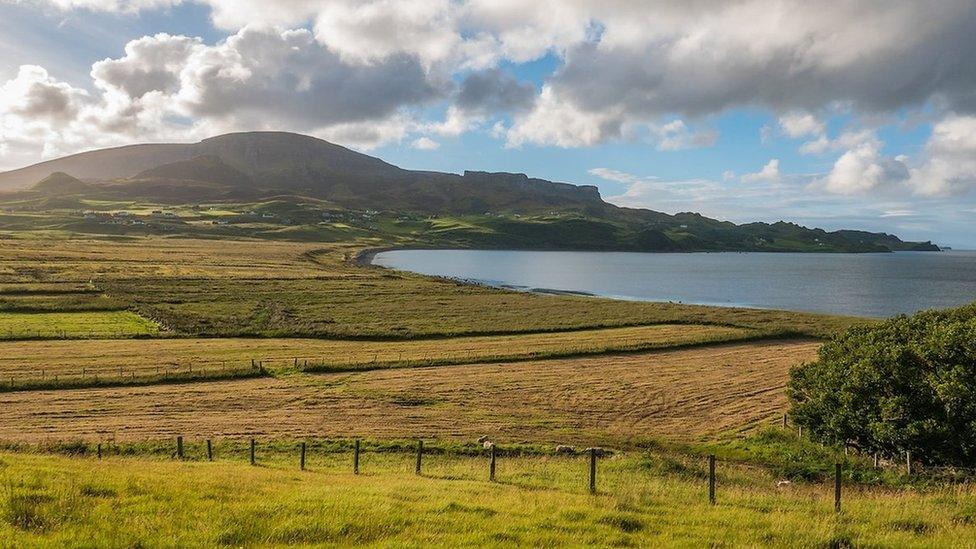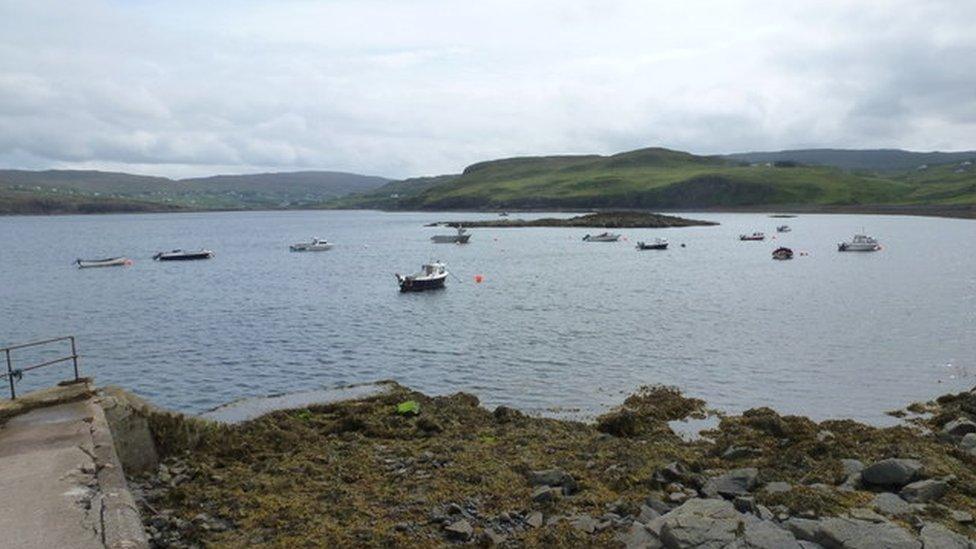Memorial to recall crofters' uprising on Isle of Skye
- Published

A contemporary memorial has been proposed for Staffin on Skye
A memorial has been proposed to recognise a crofters' uprising in the north east of Skye more than 130 years ago.
People living in Staffin were in dispute with landowners because of rent rises, insecurity of tenure and the eviction of families from land.
The unrest was part of wider period of land rights struggles known as the Crofters' War.
Staffin Community Trust is working with Atlas Arts on the project.
Applications have been sought from artists for a commission to create a contemporary memorial.
The community trust said: "History has forgotten that it was a man from Bhaltos in Staffin - one Tormod Choinnich Stiùbhart, with descendants still living and breathing in Skye - who was the first Skyeman in 1877 to refuse point blank to pay the exorbitantly increased rent demanded of him by the landlord, in return for a life of hard work and toil on his modest croft."
Creative Scotland has awarded the project research and development funding.
Atlas director Emma Nicolson said: "It has enabled us to go on a journey with members of the community trust in Staffin, investigating the many possible outcomes for a fitting memorial to the crofters' struggles."

What is a crofter?
A crofter is a person who lives and works a small area of land known as a croft. A crofter is normally a tenant paying rent to the landlord of the croft. There are also owner-occupiers, crofters who have bought their croft
A croft is a small agricultural unit. Crofts often form part of a larger estate
Source: Scottish Crofting Federation

Waged throughout much of the 1800s, the wider "war" was a dispute between landowners and communities distressed by high rents, their lack of rights to land, or facing eviction to make way for large-scale farming operations.
The process of moving families out of inland areas where they had raised cattle for generations to coastal fringes of large estates, or abroad to territories in Canada, had started with the Highland Clearances in the 18th and early 19th centuries.
Both the clearances and the Crofters' War were marked by violent clashes between people facing eviction and landowners and the authorities.
One of the bloodiest incidents of the later unrest was the Battle of the Braes on Skye in 1882.
After being attacked with stones by a crowd of men and women, about 50 police officers from Glasgow baton-charged the mob.
The unrest spread to Glendale and in 1883 the frustrated authorities called for military intervention to help round up the ring-leaders.
In early 1883, the iron-hulled Royal Navy gunboat Jackal appeared in Loch Pooltiel, off Glendale.
Marines disembarked from the Jackal and landed at Glendale's Meanish Pier to help police in making arrests.

Loch Pooltiel in Skye where a gunboat dropped anchor during the Crofters' War
But the agitation continued and Prime Minister William Gladstone ordered a public inquiry, something that had been called for previously but rejected by the government.
Backed by Royal approval, the Napier Commission was set up. It was led by Francis Napier, a respected diplomat and the 10th Lord Napier.
In May 1883, it began gathering evidence at hearings across the Highlands and Islands.
Crofters told the hearings of being denied land on which they could grow crops and graze livestock.
Landowners and estate factors defended their actions and insisted change was needed to improve the agricultural output of estates.
The commission also heard evidence of sickness and diseases that afflicted crofting families, and of women and children going barefoot in rain and snow.
In 1884, the commission published its report and it was criticised by all involved. Rather than open the way for new legislation, it indicated that the government preferred that landowners and crofters work out their differences without the weight of law.
The following year crofters put up six candidates in a general election, the first to be held after voting reform.
One of the candidates stood against the Duke of Sutherland and, while the crofters' man lost, it was a move that played a part in eroding the Sutherland estate's political influence.
The Crofters' Party did manage to get five of its candidates elected.
In 1886 the Crofters Holdings (Scotland) Act was passed. However, this legislation did not solve all the problems over land rights and disputes continued into the years between the two world wars in the 20th century.